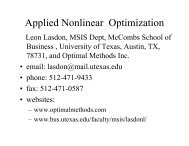[PDF] ALIO Back Matter
[PDF] ALIO Back Matter
[PDF] ALIO Back Matter
Create successful ePaper yourself
Turn your PDF publications into a flip-book with our unique Google optimized e-Paper software.
MC10<br />
■ MC10<br />
Aula 357- Third Floor<br />
Integer Programming I<br />
Contributed Session<br />
Chair: Breno Piva, IC-Unicamp, Rua Virgílio Dalben, 224, Campinas, SP,<br />
13080-570, Brazil, bpiva@ic.unicamp.br<br />
1 - Multiobjective 0-1 Integer Programming for the Use of Sugarcane<br />
Residual Biomass in Energy Cogeneration<br />
Helenice Florentino, UNESP, Depto de Bioestatística IB UNESP,<br />
Botucatu SP, Brazil, helenice@ibb.unesp.br, Thiago Homem,<br />
Adriano Lima, Lidia Carvalho, António Balbo<br />
With the gradual reduction in harvest burning, the straw derived from raw<br />
sugarcane harvest has become a focal point for researchers and producers alike. The<br />
advantages of retrieving, recovering and using have motivated university<br />
researchers and sugar mill managers and directors to find the most productive,<br />
economic and efficient way to carry out such process. The retrievement of the straw<br />
is done in four phases: first it is joined and later bundled by a compacting machine,<br />
it is then loaded into trucks and finally transported to the processing center. The<br />
feasibility of using this residue in order to generate energy is linked to the cost and<br />
the energy balance, that is, the difference between energy generated by the biomass<br />
and the energy used in the process. In this work, it is proposed the use of<br />
mathematical techniques to assist in choosing the sugar cane varieties to be planted<br />
in order to optimize the residual biomass energy balance and minimize the cost in<br />
collecting the biomass and carrying from the field to the production center, in<br />
addition to satisfying the main mill’s needs.<br />
2 - On the Chvátal-rank of Relaxations of the Stable Set Polytope<br />
Luis Torres, Escuela Politécnica Nacional, Ladrón de Guevara E11-<br />
253, Departamento de Matemática, Quito, Ecuador,<br />
torres@mail.math.uni-magdeburg.de, Annegret Wagler,<br />
Eugenia Holm<br />
We study the Chvátal-rank of the edge and clique constraint relaxations of the<br />
stable set polytope for several prominent graph classes: cliques, odd antiholes, and<br />
antiwebs. For antiwebs we derive upper and lower bounds, and propose a<br />
polynomial algorithm to compute the exact values of the Chvátal-rank. Our bounds<br />
improve the ones previously known from the literature. Moreover, we conjecture<br />
based on our computational results that one of our bounds is tight for a large class<br />
of antiwebs.<br />
3 - Advances in the Polyhedral Study of a Lot Sizing Model with<br />
Continuous Start-up Costs<br />
Ma. del Carmen Varaldo, Universidad Nacional de Rosario, Av.<br />
Pellegrini 250, Rosario, 2000, Argentina, mvaraldo@fceia.unr.edu.ar,<br />
Mariana Escalante, Javier Marenco<br />
In this work we consider a mixed integer model for single-item machine production<br />
planning with constant capacity and continuous start-up costs.Since the start-up we<br />
consider is not the standard one,we are interested in the polytope associated with<br />
this formulation.We obtain several families of valid inequalities and we establish<br />
conditions for some of them to induce facets.We also make a comparison between<br />
the facets for the model presented by Constantino in 1996 and the ones for our<br />
model.<br />
4 - Advances in the Study of Acyclic Coloring Polytopes<br />
Mónica Braga, Teaching Assistant, Universidad Nacional de General<br />
Sarmiento, J. M. Gutiérrez 1150, Los Polvorines, BA, 1613,<br />
Argentina, mbraga@ungs.edu.ar, Javier Marenco<br />
A coloring of a graph is acyclic if every induced (even) cycle in the graph is assigned<br />
three or more colors. Such colorings arise in the computational calculation of<br />
Hessian matrices. We present recent advances in the polyhedral study of this<br />
problem, by reviewing known families of facet-inducing inequalities, studying their<br />
disjunctive rank, and exploring their contribution to the practical solution of acyclic<br />
coloring problems.<br />
5 - Polyhedral Study of the Maximum Common Induced Subgraph<br />
Problem (MCIS)<br />
Breno Piva, IC-Unicamp, Rua Virgílio Dalben, 224, Campinas, SP,<br />
13080-570, Brazil, bpiva@ic.unicamp.br, Cid de Souza<br />
We give an exact solution to MCIS by addressing it directly, using Integer<br />
Programming (IP) and polyhedral combinatorics. We study the MCIS polyhedron<br />
and found strong valid inequalities, some of which we prove to define facets.<br />
Besides, we show an equivalence between our IP model for MCIS and a wellknown<br />
formulation for the Maximum Clique problem. We also report on the results<br />
of a branch-and-cut algorithm we implemented and compare them to those yielded<br />
by an existing combinatorial algorithm.<br />
<strong>ALIO</strong> / INFORMS International – 2010<br />
64<br />
■ MC11<br />
Aula 362- Third Floor<br />
Derivative-free Optimization<br />
Cluster: Nonlinear Optimization<br />
Invited Session<br />
Chair: Nélida Echebest, Universidad Nacional de La Plata, 50 y 115.<br />
La Plata, La Plata, 1900, Argentina, opti@mate.unlp.edu.ar<br />
Co-Chair: Elvio Pilotta, Professor, FaMAF - Universidad Nacional de<br />
Córdoba / CONICET, Medina Allende s/n - Cdad. Universitaria, Córdoba,<br />
5000, Argentina, pilotta@famaf.unc.edu.ar<br />
1 - Derivative Free Inexact-restoration Algorithm for<br />
Constrained Optimization<br />
Belén Arouxét, Universidad de La Plata, Departamento de<br />
Matemática, Calle 50 y 115,La Plata, Buenos Aires, Argentina,<br />
belen@mate.unlp.edu.ar, Elvio Pilotta, Nélida Echebest<br />
Derivative free optimization (DFO) methods are designed for solving optimization<br />
problems where the derivatives of the objective function and the constraints are not<br />
available because they come from industrial measure or are the results of a<br />
computer simulation. We propose a new algorithm for DFO based on the Inexact<br />
Restoration methods (Martínez-Pilotta, 2000). In our approach, the subproblems are<br />
performed appropriately in order not to use derivatives. We also present numerical<br />
experiments.<br />
2 - Some Approaches in Derivative-free Optimization<br />
Maria A. Diniz-Ehrhardt, Associate Professor, Universidade Estadual<br />
De Campinas, IMECC, Caixa Postal 6065, Campinas, SP, 13083-970,<br />
Brazil, cheti@ime.unicamp.br, Lucas Pedroso, Véra Lucia da Rocha<br />
Lopes<br />
Here we summarize our contributions in derivative-free optimization. We studied<br />
Lucidi and Sciandrone’s papers, a simplex method and the interpolation methods<br />
proposed by Powell. We also introduced a nonmonotone line-search technique,<br />
which was combined with random search directions. This scheme can also be<br />
applied for solving nonlinear least squares problems. Finally we will describe an<br />
approach for constrained problems that consists in a derivative-free Augmented<br />
Lagrangian method.<br />
3 - Derivative Free Methods for Solving Underdetermined<br />
Nonlinear Systems<br />
Raúl Vignau, UNLP, Calle 50 y 115, La Plata, BA, 1900, Argentina,<br />
vignau@mate.unlp.edu.ar, Nélida Echebest, María Laura Schuverdt<br />
The global convergence properties of two derivative free methods for solving<br />
underdetermined systems of nonlinear equations are considered. One is a Broyden<br />
Quasi-Newton method and the other is an extension of the DF-SANE method (La<br />
Cruz, Martinez, Raydan). We apply a nonmonotone globalization technique that<br />
combines the nonmonotone linesearch of Grippo, Lampariello and Lucidi with the<br />
Li-Fukushima strategy. Global convergence results are proved and numerical<br />
experiments are presented.<br />
4 - A Comparison Non Monotone Techniques for the Nonlinear<br />
Complementarity Problem<br />
Gabriel Carrizo, Teaching Assistant, Universidad Nacional del Sur-<br />
CONICET, Av. Alem 1253, Bahía Blanca, Argentina,<br />
gabrielanibal@gmail.com, Cristina Maciel, Pablo Lotito Pladema<br />
In this work the nonlinear complementarity problem is analyzed by using the<br />
Fischerman-Burmeister complementarity and the minimum functions. Since both of<br />
them allow treating the problem as a nonlinear system of algebraic equations, the<br />
proposal is to solve such a system via the Spectral Approach for Nonlinear Systems<br />
SANE,Derivative-free SANE and the Spectral Gradient methods. Numerical results<br />
are presented showing the performance of the strategies.<br />
■ MC12<br />
Aula 363- Third Floor<br />
Supply Chain and Finance Interaction<br />
Cluster: Supply Chain Management<br />
Invited Session<br />
Chair: Alejandro Serrano, Lecturer, Zaragoza Logistics Center, Edificio<br />
Nayade 5, C/ Bari 55 - Plaza, Zaragoza, 50197, Spain, aserrano@zlc.edu.es<br />
1 - A Cournot-stackelberg Model of Supply Contracts with<br />
Financial Hedging<br />
Martin Haugh, Columbia University, New York, NY, United States of<br />
America, mh2078@columbia.edu, Rene Caldentey<br />
We study a supply chain where multiple budget-constrained retailers and a single<br />
producer compete in a Cournot-Stackelberg game. At time 0 the retailers order a<br />
state-contingent quantity of a single product from the producer and, upon delivery


![[PDF] ALIO Back Matter](https://img.yumpu.com/17932960/44/500x640/pdf-alio-back-matter.jpg)
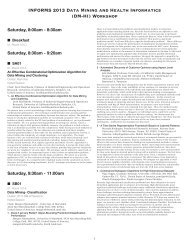
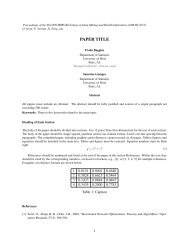
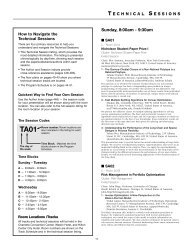
![[PDF] Charlotte Back Matter](https://img.yumpu.com/17933057/1/190x245/pdf-charlotte-back-matter.jpg?quality=85)

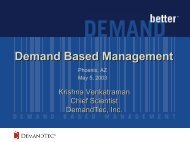
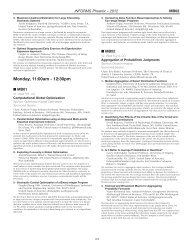
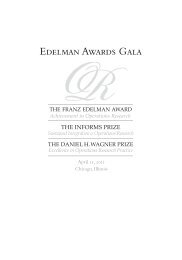
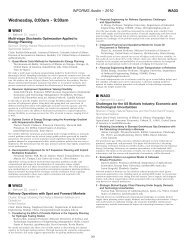
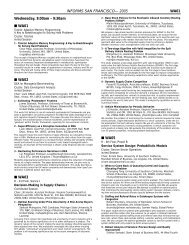
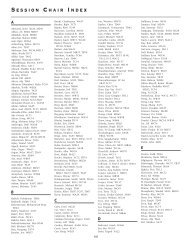
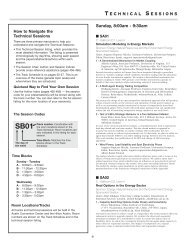
![[PDF] Monday, 8:00am - 9:30am](https://img.yumpu.com/17932954/1/190x245/pdf-monday-800am-930am.jpg?quality=85)
